|
1.
CENTRAL/ WEST AFRICA
Difficult market conditions linger for West African producers
The slowdown in new business has continued. The
European market has been very depressed, and while there
was some activity for Asian destinations even this was at a
much lower level than volumes that producers would have
considered normal only a few months ago. Producers
were matching this slowdown with reductions in output
through temporary closures of concessions and a reduction
in workforce. There were concerns that the effects on
finance and banking arrangements may cause problems for
previously negotiated agreements.
Okoume has been particularly hard hit. There has been
business for new, fresh logs, but there was a considerable
stock of older logs that would have had to be sold at low
prices, with the risk this could have also depressed the
overall okoume log market. Some producers were reported
to have ceased logging okoume and were concentrating on
the more marketable red species, while others were
logging only for their sawmills and veneer mills.
As noted previously, market conditions in all areas have
been very difficult and there was no sign of any upturn.
Although the asking prices for many log and lumber
species were reportedly relatively stable, there were some
changes, a few moving upward on demand for Asia and
short supply while the majority either moved down or
remained unchanged. There was a tendency to hide the
fierce negotiations on price which were taking place, with
sapele very hard hit and no baseline price. Buying for
Europe was very quiet. Internal trade between European
countries was reported as being more than usually
competitive with some transactions at below cost. Possibly
stockists were prepared to clear existing stock at below
cost price as they could replace stock with imports at the
present lower price levels.
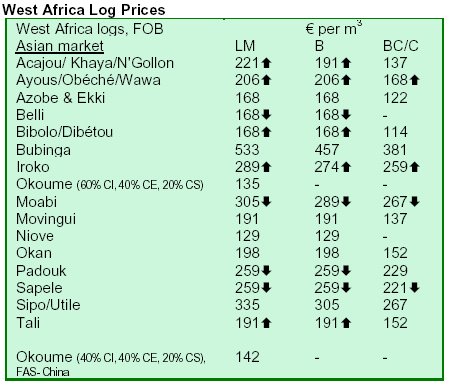
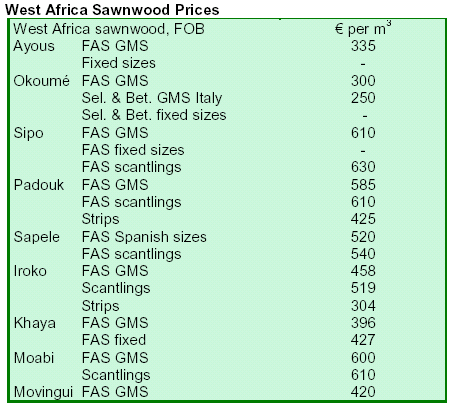
2. GHANA
Lumber tops first quarter timber contracts
The Contract Section of the Timber Industry Development
Division (TIDD) processed and approved a total contract
volume of 156,938 m3 during the first quarter of 2008. The
section also processed the approval of 54,866 pieces of
furniture parts during the same period. Compared to the
last quarter of 2007, the contracts approved represented
increases of 13% and 28.48% respectively. The significant
percentage increase in furniture parts could be attributed to
the anticipated high demand of the product in Europe
during summer 2008. For instance, garden furniture parts
accounted for about 80% of contracts approved for
Scanstyle Mim Company Ltd during the first quarter of
2008.
The volume of lumber rose sharply to 68,212 m3,
representing an increase of 31.52% as compared to the
volume for the previous quarter. Lumber accounted for
43.46% of the total contract volume approved during the
period. Teak lumber was 7.60% of the total lumber
volume, representing 5,187 m3.
The total plywood volume was 47,401 m3 for the period,
increasing 26.72% when compared to the previous quarter.
There were decreases in the volume of contracts processed
for sliced veneer, boules and poles/billets/logs. These
products dropped 5.83%, 65.90% and 29.19% and reached
volumes of 9,253 m3, 282 m3 and 19,789 m3 respectively.
Three area contract offices in Kumasi, Accra and Sunyani
processed and approved 29.92%, 4.64% and 11.73%
respectively, which together accounted for 46.29% of the
total contract volumes approved. The Takoradi office
accounted for the remaining 53.71%.
Export permits register marginal gains in 2008
During the first quarter of 2008, a total of 2,167 export
permits were issued to cover the shipment of various
timber and wood products through the ports of Takoradi
and Tema and overland to neighboring countries. Total
export permits for the quarter registered a marginal
increase of 1.07% when compared to that in October to
December 2007.
Lumber, both kiln-dried and air-dried, continued to
register the highest number of export permit applications,
representing 43.65% of the total number of export permits
issued during the period under review. By implication, the
demand for this product was higher than for tertiary wood
products like furniture parts, mouldings, floorings, dowels,
broomsticks and profile boards.
In Takoradi, a permit was issued for the shipment of
eleven (11) pieces of polished coconut carved shower
stands, which were shipped to Amsterdam in the
Netherlands. Three permits were also issued to the
Machined Wood Company Ltd for the shipment of
okoume mouldings totaling 97.668 m3 and valued at
EUR61,531 to Italy. These mouldings were made from
okoume sawn timber, which were imported from Gabon.
ECOWAS sub-regional market boosts overland exports
Ghana¡¯s overland plywood and lumber exports for the first
quarter of 2008 were 28,664 m3 and worth nearly EUR8
million. Eighteen companies altogether exported plywood
and/or lumber by road to Burkina Faso, Nigeria, Niger,
Mali, Benin and Togo. These figures, compared to the last
quarter figures of 28,929 m3 and EUR7,526,005, showed a
marginal fall of 0.92% in volume although there had been
a gain of 6.28% in the value of permits issued. This
increase in the value of overland exports was a reflection
of the rising importance of the ECOWAS sub-regional
market for imports of plywood and lumber.
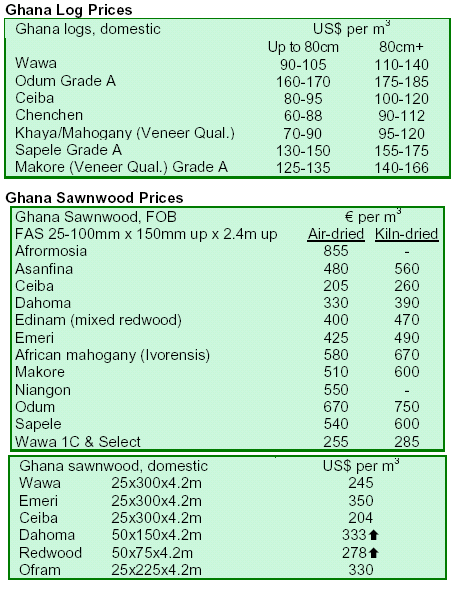
3.
MALAYSIA
Malaysia¡¯s trade with China grows 25.1% by value in 2007
Based on 2007 statistics from China¡¯s Customs Agency,
China is one of Malaysia¡¯s top ten trading partners,
reported The Daily Express. Ahmed Aziz, a member of the
Board of Directors of the Malaysia External Trade
Development Corporation (MATRADE), commented that
Malaysia¡¯s total trade with China reached USD46.4
billion, a rise of 25.1% from 2006 levels. Malaysia¡¯s
exports rose 21.89%, reaching USD28.4 billion last year.
According to Aziz, Malaysia¡¯s exports USD500-600
million worth of timber products to China annually.
Malaysian property development industry grappling with rising costs
The Star reported that the Malaysian property
development industry is getting nervous as oil prices
continue to soar. Rising prices of building materials,
inflationary trends in the cost of living, global economic
uncertainties, rigid policies for developers and a softening
market are also concerning the industry. Property
developers are also facing eroding profit markets, higher
construction costs, intense competition and fear that rising
inflation is affecting buyers¡¯ sentiment. Many contractors
are demanding an upward revision of their contact prices
and threatening to walk if their demands are not met.
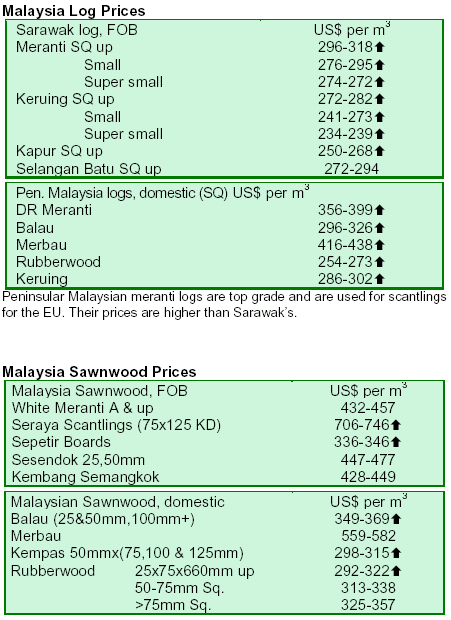
4.
INDONESIA
Asmindo and Senada encourage use of verification stamps for market access
The Jakarta Post reported that Asmindo (the Indonesian
Furniture producers Association) and Senada (a US
Agency for International Development project) held a
meeting in which participants discussed how wooden
furniture producers verified under third-party sustainable
forest or legal logging licenses are guaranteed better
access to international markets. Using the verification
stamp of sustainable forest management (SFM), producers
can assure buyers that their product was made from a
sustainably managed forest. The Verification of Legal
Origin (VLO) and Chain or Custody (CoC) stamps prove
the legality of the wood supply.
Senada¡¯s project director, Steve Smith, said that
verification was a stepping stone to tracking legal timber
and that the market would eventually require all furniture
to be produced from sustainably managed timber sources.
Seneda was also working with certification bodies and
consultants to provide assistance for the VLO and FSC
certification processes for at least 40 furniture companies
in Indonesia.
Asmindo chairman Ambar Tjahyono said more buyers
required these verification stamps, especially since the US
and EU have been developing new bilateral and
multilateral measures that would prevent imports from
unsustainable and illegal sources. Asmindo estimated that
wooden furniture exports rose 10% in 2007, reaching
USD897 million when compared to USD816 million in
2006.
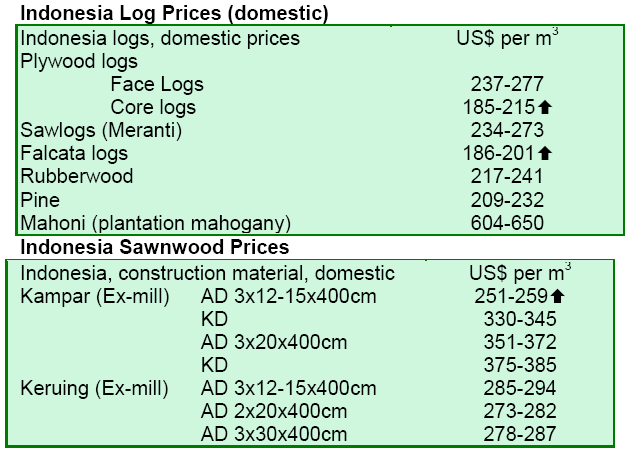
5.
MYANMAR
Replanting mangroves viewed as long-term effort
Vice Chairman of Friends of the Rainforests in Myanmar,
Dr. Kyaw Tint, said it would take nearly fifteen years to
replant the mangroves destroyed by Cyclone Nargis,
reported news sources in Myanmar. The Forest
Department and NGOs concerned with the development of
the environment will work together to formulate plans to
plant the mangroves. However, he said that more of a
focus should be placed on rehabilitation efforts at present
and replanting should be done only after living conditions
of the people in cyclone affected areas have been
stabilized. He added that the presence of mangroves will
help mitigate future natural catastrophes. In replanting the
mangrove forests, he said, priority should be given to fast
growing species.
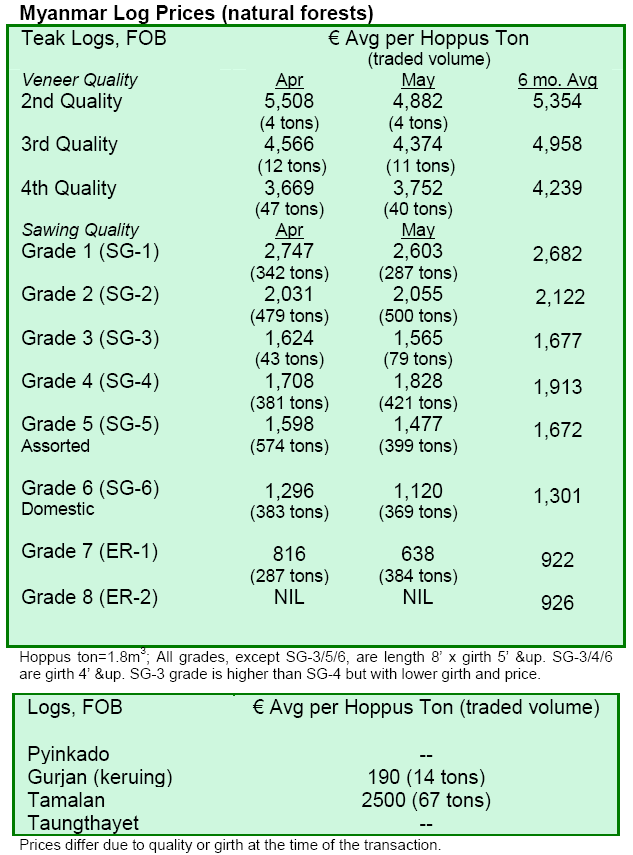
6.
BRAZIL
Maximum limit of forest conversion in the Amazon may
rise
The coordinator of the Sustainable Amazon Program
(PAS) of the Brazilian government has indicated the
possibility of increasing the maximum limit of forest
conversion to other uses in rural properties in the Amazon
region to above 20%, reported Folha Online and Ambiente
Brasil. The adjustment does not depend on changes to the
Forest Code, which is being discussed in the Congress. It
refers to a provision that allows the reduction of the legal
reserve from 80% to 50% for the purpose of forest
restoration under two conditions: (i) indication of
ecological-economic zoning, and (ii) the endorsement of
the National Council for the Environment (CONAMA),
and the Ministries of Environment and Agriculture.
There are already state laws for zoning in the Amazonian
states of Acre and Rondônia. However, many
municipalities fail to follow legal guidelines that set aside
80% of a property for protection. According to the
Environment Ministry (MMA), only three municipalities
(out of the 36 municipalities that deforested the Amazon
the most) follow the 80% forest protection rule. On
average, the target areas of deforestation control
operations have lost 50% of their forests. In Brasil Novo, a
municipality in state of Par¨¢ where most deforestation
takes place, there are only 17% of forests left.
The Minister of the Environment supported the creation of
a ¡®belt¡¯ in the transition area between savannah and the
rainforest, where the population would develop
economically feasible and environmentally friendly
production activities. He also emphasized that the
rainforest is not an agricultural frontier, despite official
information pointing out that 40% of the national
production of soybeans and meat come from legal areas of
the Amazon. In contrast to deforestation measures adopted
by the government, the PAS coordinator emphasized that
the governmental actions would reach small producers and
the settlement of agrarian reform as well. So far, there is
no deadline set to announce the results of the PAS.
Arco de Fogo operation to target large scale operators
Reports from the Ministry of Environment and Ambiente
Brasil indicate that inspection operations to combat
deforestation in the Amazon will be intensified under the
Arco de Fogo Operation (see TTM 13:4-7 and 9). The
Minister of the Environment met the director of the
Federal Police to define a schedule of the third phase of
the operation. Besides the Federal Police and IBAMA, the
operation will be supported by the Civil Police and the
Army, especially to help with logistics, transportation and
storage of illegally seized goods. In the new phase of the
operation, roads, junctions of major roads, and
watercourses will be the focus of the inspection, in
addition to timber processing-mills and charcoal-based
steel mills. The priority will be on large-scale operations.
Furthermore, the Minister announced that he will negotiate
cooperation agreements between the Ministry of the
Environment (MMA) and the states of Rondônia and Mato
Grosso, similar to the model developed with state of Par¨¢
last March. Under the agreements, the state authorities
support the transportation and auction of illegally seized
timber. Sale of these seized products will help to pay the
costs of police activities in the region. For instance, sales
of only 10% of the total timber recently seized in the
municipality of Tailandia in state of Par¨¢ were equivalent
to the total cost of Arco de Fogo operations since February
2008.
In the first meeting with the newly appointed Minister of
the Environment, the federal police discussed the results of
the Arco de Fogo Operation carried out so far in the
Amazon. Since March 2008, the Federal Police and
IBAMA closed 359 forest properties, a total of 63,000 ha;
seized 79,300 m³ of logs and 26,700 m³ of illegally
processed timber; and imposed BRL 361 million in fines.
Wood products exports fall in May by 17.6%
In May 2008, the value of exports of general wood
products (except pulp and paper) fell 17.6% compared to
the same period in 2007, from USD369.8 million to
USD304.6 million. The charts below show the volume and
value of exports for May 2008 compared to the same
month a year earlier:
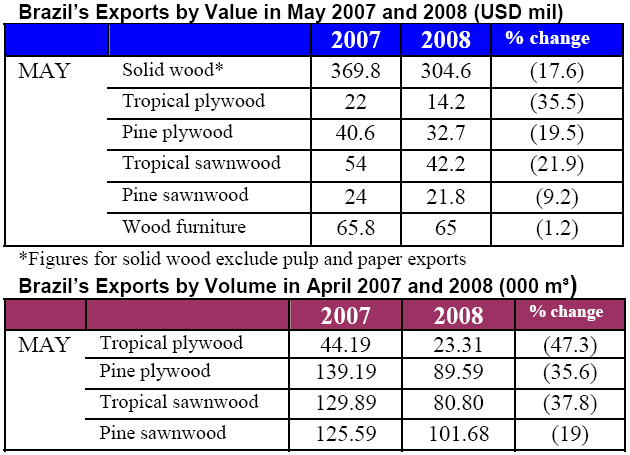
Alta Floresta producers shift to domestic market
According to S¨® Not¨ªcias, exports from Alta Floresta
companies decreased in the first five months of 2008.
Total exports worth USD6.2 million were 25% lower than
observed in the same period of 2007, when they were
valued at USD8.4 million. The value of exports fell since
their highest level in January 2008, when exports totaled
USD1.6 million. In May, however, exports were only
worth USD757,000.
Trade with the US alone decreased 36%, dropping from
USD4.2 million in January to May 2007 to USD2.7
million during the same period in 2008. Exports to Spain
were worth USD1.5 million during the 2008 period.
The main reason for the dramatic changes in exports was
the weak US dollar, which has been fluctuating between
USD1=BRL 1.61 and USD1=BRL1.63 in June. In May, it
reached its lowest in the past nine years, with an average
of USD1=BRL1.64. Thus, exports of forest products in the
region have become less profitable and the domestic
market has become more attractive for Alta Floresta
producers, mainly due to the expansion of the civil
construction market.
Total forest products trade of the state Mato Grosso in
May 2008 was BRL141 million, out of which BRL24.7
million (17%) were sold to other states, BRL83.5 million
(59%) exported and BRL33.2 million (23%) sold within
the state. In April, wood products sales reached BRL139
million, out of which BRL30.8 million (22%) went to
other states in Brazil, BRL79.8 (57%) to the international
market and BRL28.4 million (20%) to sales within the
state.
Paran¨¢ State heightens attention to domestic markets
With a decrease in exports to the US over the past 2 years,
the wood industry of the state of Paran¨¢ has increased its
focus on the domestic market, taking advantage of the
boost from the civil construction market in Brazil. Paran¨¢,
the largest national producer of pine plywood, has
expanded its sales to markets such as Europe, the Middle
East and Africa.
According to the Brazilian Association for Mechanically
Processed Timber (ABIMCI), Europe ranks first among
the largest importers of pine plywood from Brazil. In the
first two months of 2008, out of 313,000 m³ of pine
plywood exported, Europe purchased 246,000 m³ (79%)
while the US purchased 29,000 m³ (9%). Africa and the
Middle East together imported 13,000 m³.
The slow pace of civil construction in the US, considered
the lowest in the last ten years, and the depreciation of US
dollar have affected exports of pine plywood, doors and
frames used in civil construction. Brazil exported 1.2
million m³ of pine plywood to the US in 2005, but
exported only 347,000 m³ in 2007. Companies have
started to diversify their products and invest in the
production of added-value products.
In the last two years, many companies in the wood
industry had to reduce production, lower costs and cut
personnel due to decreased demand from the US and
unfavorable exchange rates. Some Brazilian producers are
now shifting exports from the US to Europe, Mexico, Asia
and Africa. Ninety percent of plywood production
(4,000m³/month) is currently oriented to European
markets alone. Companies are also trying to invest in
supplying the domestic market, but admit that the potential
of the domestic market is limited, since Brazil does not
have a tradition of building wood framed houses.
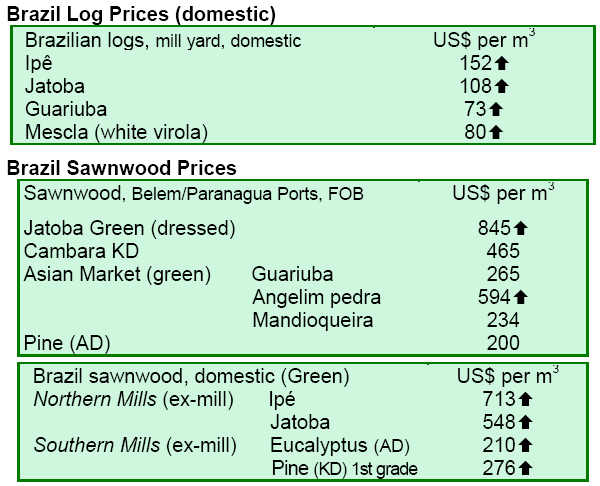
7.
PERU
New forestry law in Peru modifies country¡¯s SFM
guidelines
A new forestry law was gazetted in Peru at the end of
June, which details new requirements for forest
management in the country. The provisions of the new law
include: all CITES-listed timber species must be field
verified prior to logging; all log and timber transportation
means (such as skidders and trucks) must have a GPS
tracking system; logging bans on species can be called for
in areas outside of forest concessions with approved
management plans; criteria and indicators are required to
track sustainable forest management progress in
concessions; and palm oil, palm heart, bamboo, and other
plantations previously categorized as agro-industrial are
now categorized as forest plantations. The total
implementation cost of the new law has not yet been
announced.
First quarter exports jump 34.2%
Peruvian wood sector exports from January to April 2008
were USD80.44 million (FOB) up from USD62.64 million
in 2007, an increase of 34.2%. This was due to increased
demand from Mexican and Chinese markets. Exports in
April 2008 grew USD7.07 million compared with exports
for the same month in 2007, since cost savings were
achieved by shipping exports to Mexican markets via boat.
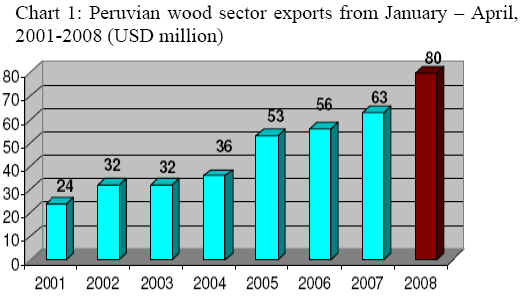
The fastest growing export products in the first quarter
were building products (123%), sawnwood (34%) and
wood plaques and plywood (32.1%). Products that have
decreased include furniture and furniture parts (¨C13.8%),
since the US market was the destination of more than 80%
of Peru¡¯s production. Products that have shown a high
increase in exports were wood parts, with cumaru as the
most popular type.
Sawnwood was still the principal export business,
representing 50.9% of exports from the sector. Exports in
the January to April 2008 period were USD41.01 million
while for the same period in 2007, exports were USD30.55
million. Sawnwood exports in April 2008 increased
USD6.57 million compared to the same month in 2007.
Sawnwood exports in this period rose due to an increase in
exports of species such as cumala, cedar, tornillo, congona
and odorless estoraque.
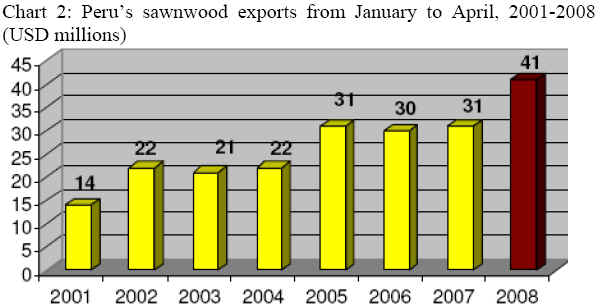
Semi¨Cmanufactured products represented 25.9% of wood
sector exports. Exports during the January to April 2008
period were valued at USD20.02 million and exports for
the same period during 2007 were USD17.02 million, a
year-on-year increase of 22.6%. Exports of semi¨C
manufactured products in April 2008 grew USD95.16
million from the value of products during the same period
in 2007. The increase in this sub-sector was due to the
progressive rise in exports of wood pieces and decking, for
which China was the main market.
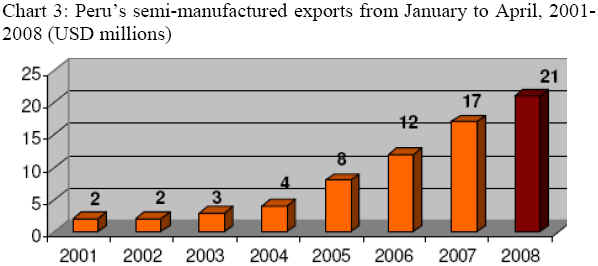
Exports of furniture and furniture parts were worth USD
4.81 million for the January to April 2008 period. Exports
for the same period in 2007 were USD5.57 million,
resulting in a 13.8% drop in exports for 2008. Exports in
April 2008 decreased USD438,350 from the same month
in 2007. The drop was due to the fall of imports to the US,
the main destination for Peru¡¯s furniture.
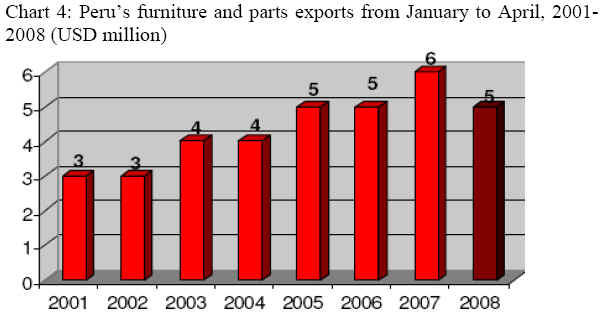
Exports of wood plaques and plywood exports for the
January to April 2008 period were USD9.62 million, up
32.1% from the same period in 2007. By value, however,
exports of wood plaques and plywood in April 2008 fell
USD345,940 from the same period in 2007. Mexico was
the main export market for wood plaques and plywood,
although the sector was boosted by growing demand from
the Venezuelan and Central American markets.
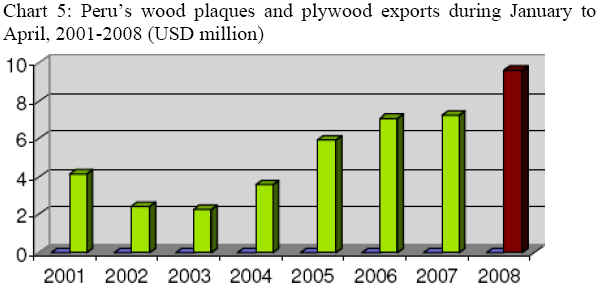
Peru¡¯s three main export destinations for the January to
April 2008 period were Mexico, the US and China. In the
first quarter of 2008, Mexico remained the main export
destination, growing almost 100% compared to last year.
Mexico represented 40.1% of exports. Exports to the US
decreased 14.9% while exports to China, the third
destination market, increased 30.1%. Nevertheless, there
are new market destinations such as Venezuela, Canada
and France that may overtake the current top three
destinations.
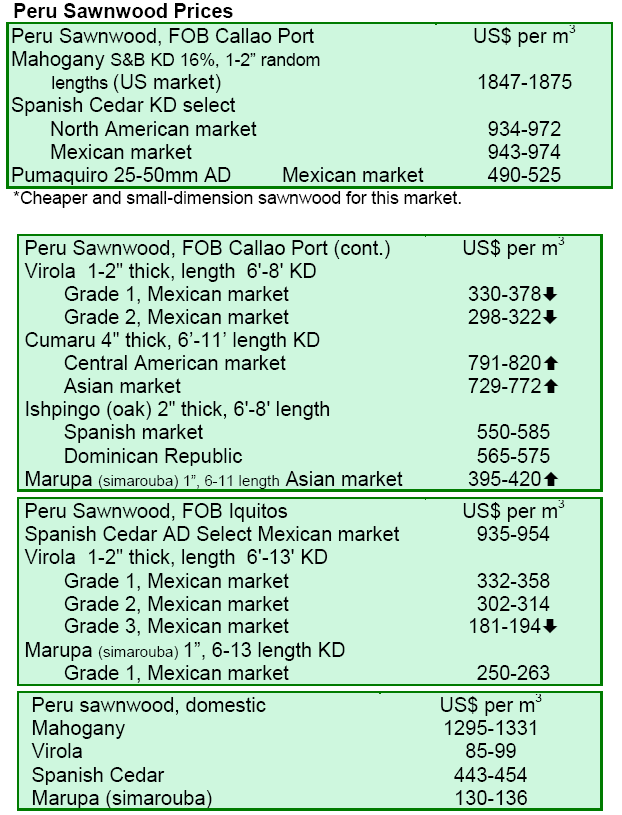
8. BOLIVIA
First quarter exports from La Paz and Santa Cruz drop
26%
Exports of forest products from La Paz and Santa Cruz
during the period January to March 2008 slipped 26%
compared to the same period in 2007. By value, exports
fell from USD28.59 million in 2007 to USD21.10 million,
breaking a positive trend that has occurred since 2002.
Among the reasons for the decrease are the ¡®El Nino¡¯ and
¡®La Nina¡¯ effects, the shortage of diesel fuel, the falling
value of the US dollar, the US mortgage crisis and the
legal complexities facing forest operators.
Processed wood, including furniture and furniture parts,
plates and sheets, chairs, chestnut without husks and
canned palm hearts constituted 63.91% of total forest
products. The remaining 36.09% were from semiprocessed
products such as sawnwood, boards and poles.
Exports of wooden products were 91.73% and worth a
total USD19.36 million. Non-wood products were
USD1.75 million or 8.27%, with the main product being
chestnut without husks. Exports of non-wooden products
fell 29% when compared to 2007.
Among the 31 exported products, there were eleven fewer
than in 2007. Sawnwood was the most important export
product, with a value of USD7.57 million, followed by
doors worth USD2.47 million, plates USD1.68 million,
other furniture products USD1.45 million, parquet
USD1.19 million and chairs USD1.1 million. By volume,
the main exported species were oak, almond trees, tajibo,
quina quina, morado and curupau. The US was the largest
recipient of Bolivia¡¯s wood products by value, receiving
USD8.01 million of products, followed by China with
USD1.86 million. A total of 38 countries purchased
Bolivian forest products, six more than in 2007 and 19
engaged in contracts worth USD100,000.

9. MEXICO
Mexico joins efforts to fight desertification
Many areas of Mexico are affected or are susceptible to
some level of land degradation. The main factor of land
degradation is deforestation and changing land-use. In
order to stimulate efforts to avoid or prevent
desertification, Mexico joined the World-wide Day to
Fight Desertification on 17 June 2008, a date selected by
the UN Commission on Sustainable Development. Mexico
has been working to mitigate the adverse impacts of loss
in land productivity, undernourishment, impoverishment
of the population and forced migration. At the domestic
level, Mexico works though its ProArbol programme to
promote forest conservation and restoration of degraded
areas and has established a National System against
Desertification and Degradation of Natural Resources.
10.
GUYANA
Intra-regional trade to the Caribbean boosts export
results
Guyana¡¯s exports of mouldings for the fortnight have
improved over the previous month¡¯s total, mainly due to
the large export volumes of purpleheart mouldings to
Barbados. Export volumes of value-added products (e.g.
doors) to the Latin America/Caribbean region have seen
robust increases of 61.9% when compared to the same
period of 2007. Further comparison between the same
period of 2007 and 2008 revealed that Barbados remained
the main destination for value-added products, while
Grenada and Trinidad & Tobago increased their
consumption by over 30%.
The average price for greenheart logs continues to climb,
reaching a 9.5% increase over the recent highs of USD126
per m³ to USD138 per m³ on average, with a maximum of
USD180 per m³. The average price for mora and
purpleheart logs increased by 16% and 7.6% respectively
over previous months. Export volumes of logs have yet to
improve.
Guyana to hosts ITTO C&I Workshop
Guyana hosted an ITTO workshop on revised Criteria and
Indicators (C&I) for the management of tropical forests in
Georgetown, Guyana during 23-26 June 2008. The
workshop hosted representatives from the forest sector in
Guyana including several key community groups, private
operators, governmental and non-governmental agencies,
conservation groups, donor bodies and education and
training institutions. The workshop addressed several key
areas including Guyana¡¯s progress toward reporting and
implementing ITTO C&Is, training and capacity building
in understanding and reporting on C&Is as well as areas
such as forest certification, legality and reduced impact
logging.
The structure of the workshop covered both classroom
sessions and field activities to give participants practical
input on the practical application of ITTO C&Is. The
workshop was jointly coordinated by the ITTO and the
Guyana Forestry Commission and facilitated by an
international consultant. Readers will be updated on the
results of the workshop in coming reports in the
forthcoming ITTO Tropical Timber Market Reports and
the ITTO Tropical Forest Update.
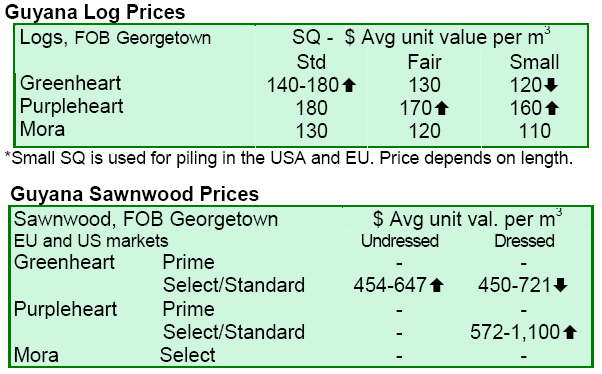
|